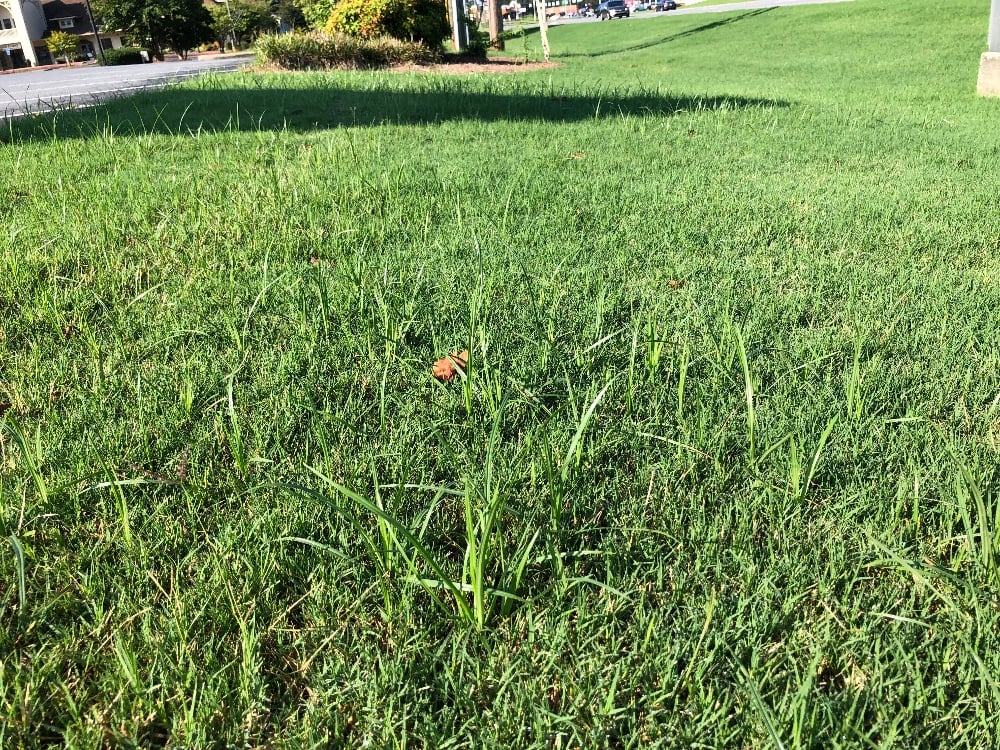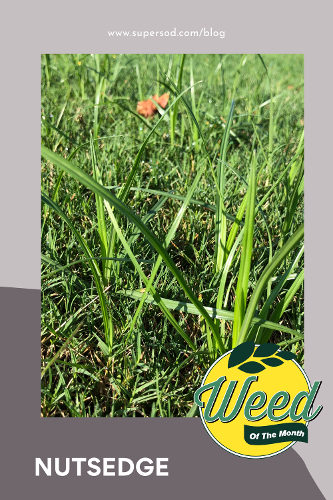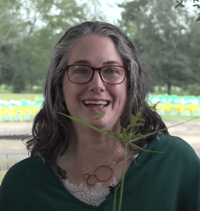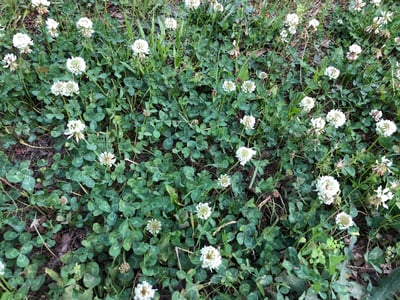

The featured weed is Cyperus esculentus aka yellow nutsedge, nutgrass, tigernut, earth almond, or chufa. We'll cover how to identify and control it.
Yellow nutsedge is one of the most widely distributed weeds in our weed series, and is native or naturalized over much of Africa, Eurasia, South America, and North America.
It's a Sedge, Not a Grass
Yellow nutsedge is fond of invading lawns. It's a unique type of plant and is not a grass, even though it looks like one. There are several related sedge species, but yellow nutsedge is the most common in lawns.
They look like grasses because they are also monocots. Monocots are a group of plants with one cotyledon (cotyledons are the first leaves to emerge from a seed) and have parallel leaf veins, amongst many other characteristics. The phrase used to guide confused students in botany classes is, "it's a sedge, not a grass."
Let's start with a botanical discussion of nutsedge.
Viewing Tip: Increase the volume and the playback speed according to your preferences. Volume control is the speaker icon on the lower left; playback speed is the gear button on the lower right.
Yellow Nutsedge ID Features:
To control nutsedge, we first need to learn how to identify it.
- Family: Nutsedges are in the Cyperaceae family, or sedge family.
- Habit & Stems & Roots: Yellow nutsedge grows in 6 to 24" tall clumps from little bulbs that also send out rhizomes to colonize large areas. Normally in lawns I see 6 to 12" tall plants; in unmowed ditches they get much larger, to knee high. The bulbs and base of the stems can be reddish.
- From the bulbs the underground runners spread and form the tubers. These runners are rhizomes and are a type of spreading stem, albeit an underground stem.
- Tubers are storage organs (think: potato) so have a lot of pent up energy and are one reason yellow nutsedge is so hard to kill. These tubers are called "nutlets" on this plant, hence nutsedge.
- Leaves: Leaves are light yellow-green with a waxy coating. Like dallisgrass, they outgrow turf and will shoot up past the lawn, even if you don't miss a mowing.
- Flowers: The flowering stems are triangular in cross section all the way up from the base of the plant to the flower. A picture below shows this unique characteristic of sedges. The shape of the flower is an umbel (like carrot and parsley flowers) of multiple spikes that start greenish-yellowish and turn straw or tan colored as they age.
A yellow nutsedge colony in Bermudagrass.
Base of stems can be reddish.
Drying flowers heads on a 2' tall plant in a ditch.
The flowering stem is triangular in cross section. You can feel the three sides when you roll it between your thumb and fingers.

This grass-like perennial plant loves full sun and especially loves wet or moist soils, yet tolerates dry soils too. These are the adaptive reasons it's ubiquitous in lawns. The nutlets and glossy leaf surface are what makes it hard to eradicate. A quadruple whammy!
Yellow nutsedge thrives in hot weather and appears in our lawns when the soil is good and warm. There have been several spring seasons where I've thought an infestation magically disappeared from my garden, only to see the light green leaves come shooting up through the lawn in June (zone 8 in Georgia).
The most common nutsedge weeds in the Southeast come in two colors: yellow and purple. We're currently discussing yellow nutsedge in this article; Purple nutsedge is Cyperus rotundus, an invasive from Eurasia.
Here are some other sedges that can be mistake for yellow nutsedge.
Cyperus globulosus - globe sedge from UGA Turfgrass & NC State Extension
University of Florida extension service has a good article featuring common Cyperus in the Southeast, such as water grass, killinga, globe sedge, and cylindric sedge.
Carex is another type of sedge that could be mistaken for Cyperus sedges. They are in the same Cyperaceae family, but are a different genus. This grass-like perennial also has triangular flower stems and grows in clumps (some send out runners to colonize; some don't). There are scads of native and imported Carex species that are grown by gardeners due to their showy yellow, blue-gray, bronze-orange, or variegated leaves. I don't know of any that invade lawns to the extent that Cyperus species do.
Learn more about nutsedge (yellow & purple) from these websites:
- NC State Extension features two nutsedges
- UGA Turfgrass has yellow nutsedge and purple nutsedge listed in its database
- Clemson has an enlightening article on nutsedges
Eat it or Treat it - How to Control Nutsedge
I recently learned yellow nutsedge is another edible weed and perhaps, like me, you'll be surprised to learn that if you've enjoyed a glass of Horchata then you've already tried it!
My first clue was in the scientific name, Cyperus esculentus . . . where "esculentus" means edible in Latin. The tubers that are so hard to get rid of are the edible part. Next time I have an exasperating moment with nutsedge, I'm considering eating it in revenge.
Then my boss, Ben Copeland Jr., informed me the tubers are made into Horchata. That was shocker.
Even though it's edible, that doesn't mean we appreciate it growing in the lawn we're working on cultivating to perfection. However, I hope this knowledge helps you consider different ways to deal with the plant. Here's how to get rid of it in your lawn.
Cyperus species of sedge can be hard to tell apart, but for purposes of eradication they are all treated the same.
Nutsedge Weed Prevention:
- Pre-emergent herbicide: Yellow nutsedge is a perennial so pre-emergent will not remove plants that are established, however a routine pre-emergent program in winter/spring should take care of new infestations occurring in your lawn and garden. There are pre-emergent herbicides (such as Pennant Magnum) labeled for use in lawns to prevent new nutsedge infestations, but you will need to call a pro to apply them. There are pre-emergents (such as Freehand and Snapshot) labeled as safe in ornamental beds, but please note that those two are not labeled as safe for lawns.
- Prevent nutsedges in beds with thick layers of mulch and by cultivating a thick, healthy lawn so seeds don't have a place to germinate.
- If bad spots develop, such as due to utility work in a ditch, get individual rolls of sod and cover those bare spots before more weeds germinate there.
- Yellow nutsedge prefers low-lying and periodically wet areas, so those areas may be where you have the worst infestations. Try correcting any problems with standing water by diversion or adding topsoil.
- Monitor irrigation to prevent over watering. Yellow nutsedge thrives in over-watered lawns.
Manual Removal of Nutsedge:
- Hand pull: You have probably learned the hard way (like me) that it's satisfying and easy to pull up yellow nutsedge and . . . that it is futile. The satisfaction doesn't last long when it sprouts right back in the same spot. Those nutlets regenerate new bulbs that keep coming back. If you have guests coming, hand pulling works to get this weed out of sight, but it will come back. Theoretically it works to starve out the biomass by yanking off it's source of photosynthesis, but for this weed you have to become obsessed with regular hand weeding to make it work.
- Mow to keep plants from going to seed and creating even more colonies. If you have yellow nutsedge infestation, consider mowing more frequently to help suppress the rapid growth.
- Time/patience: Since yellow nutsedge is a perennial, you can't simply wait for hard frosts to kill it off. Your patience is going to be frazzled by this weed. It will take long-term persistence and patience to get rid of it using the tips herein.
Chemical Control of Nutsedge:
- A non-selective herbicide can be sprayed to kill colonies of yellow nutsedge, but it will also kill the surrounding lawn. Plus, it may take repeat applications and it may not kill the nutlet from which it regrows. Because yellow nutsedge enmeshes so thoroughly with lawns, the cardboard shield technique I recommended for dallisgrass is not as effective with this weed. If you choose a kill-all herbicide, steel yourself for possible repeat applications and for your lawn to die out too; plan on getting rolls of sod to fill in those bare spots.
- Post-emergent herbicide: We recommend selective herbicides with Halosulferon-methyl as the active ingredient to kill out nutsedges without destroying your lawn, such as our Halo 5WDG Select.
- Yellow nutsedge has a glossy coating that can be hard for herbicide to penetrate. For this reason we recommend using a surfactant when applying herbicides. Individual packets of Sedgehammer+ have surfactant included in the product (that's what the + means).
Questions? Leave a comment below.
If you're a weed aficionado like me, check back here for future weed profiles. Until then, happy weeding!
All pictures by Hillary Thompson. Special thanks to Ben Copeland Jr. and Greg Nichols for contributing nutsedge ID and treatment tips.






